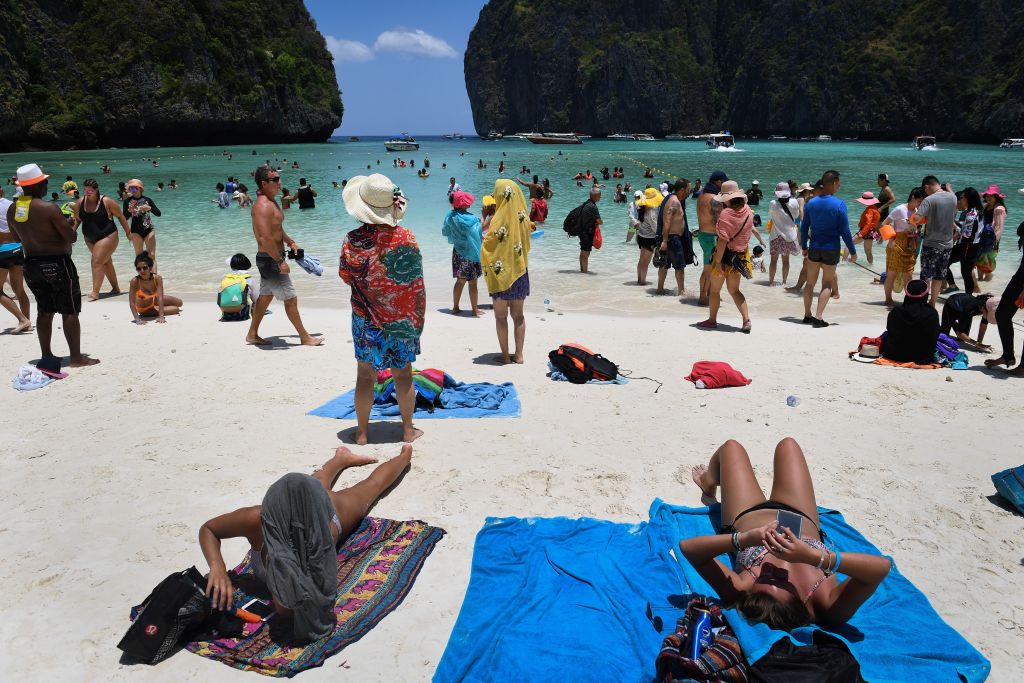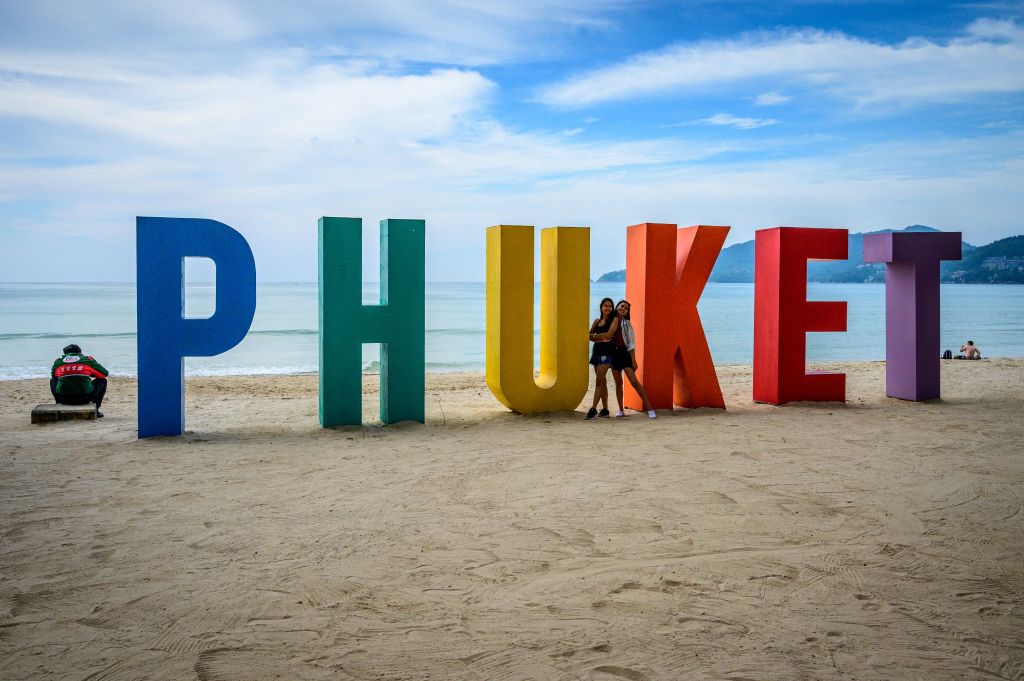Sstood on a crowded corso in Tonsai Bay last Saturday to see Thailand'stourismstagnant. It was difficult to confirm. Thousands of visitors, sandals and smartphones held high, were amphibious landings from throngs of tourist boats and marching on the beach.
Tonsai is a noisy hangar-like structure designed for day-trippers to Phi Phi Island, the largest island in the Phi Phi Islands, to efficiently feed large groups of people. where to have lunch at one of the two restaurants in cheap buffet. Then they pack onto the beach for the obligatory selfie, scouring out a few square feet of uncrowded sand to save the Instagram Phi Phi myth.
Read more: It's the summer of revenge travel.
But the sight is disturbing when you see a boyish Thai guide standing nearby with unkempt bangs and thick earrings. . He gritted his teeth and exhaled, saying the crowd was "less than half" what it was before the pandemic began in early 2020. He lives in the UK and scans faces mainly in the Middle East, South Asia and Europe. Beijing's strict COVID restrictions have dried up Thailand's largest tourism market. Its revival is eagerly awaited by all levels of the Kingdom's tourism industry, but can world-famous islands like Phi Phi Island cope with business as usual? The fate of the most famous attraction, Maya Bay, stands as a warning.

This photo was taken on April 9, 2018 Photographed on the day shows tourists sunbathing and walking at Maya Bay on Koh Phi Phi, Thailand
LILLIAN SUWANRUMPHA/AFP via Getty Images
Overtourism
Maya Bay in Phi Phi Leh was adapted from Danny Boyle's 2000 film starring Leonardo DiCaprio Known as the filming location for Beach. Part of the Hat Noppharat Tharamu Phi Phi Islands National Park, the stunning cove is surrounded by dramatic cliffs and boasts an exquisite 250-meter white crescent-shaped strand, the platonic ideal of a beach. .
After the movie, the visitors' trickle into Maya Bay became a deluge. As many as 4,000 tourist boats arrived each day, damaging corals and frightening blacktip reef sharks that used the bay as a mating pool. The crowd trampled the delicate seabed. To contain further damage, authorities closed his Maya Bay to tourists in June 2018.
When it reopened in January this year, visitors were limited to 380 per hour, not he per day. Boat approaches were prohibited, as was swimming. Tourists had to disembark at the pontoon jetty on nearby Loh Samah Bay and walk to Maya. Not enough. Environment Minister Varawut Silpa-archa said that despite the new measures, Maya Bay became "flooded" during Songkran, the country's New Year holiday in April. rice field.
At the beginning of August, the famous cove was again closed for two months. This is equivalent to roping down from the Eiffel Tower in Paris or the Colosseum in Rome.
If wave conditions permit, the tourist boat will sway at the mouth of the bay for a few minutes, allowing dismayed passengers to take photos from a distance before proceeding to Pilehe Lagoon. The latter is another social media hotspot, and it's easy to see why tourism is both a blessing and a curse for these tiny islands. In Pileh, party he boats are moored beneath spectacular limestone cliffs blaring loud music. Plastic bottles and cigarette butts wash up on the rocks.
READ MORE: Can Barcelona mend its love-hate relationship with tourists?
Thong Tamron Nawasawat, a marine scientist and Maya Bay expert at Kasetsart University in Bangkok, told Time magazine that 70 to 80 percent of the cove's reefs are his. 30 years ago it was said to have been intact. When the bay closed in 2018, only 8% of the reef was alive. During the three-year closure period, Thon et al. replanted tens of thousands of new corals,about 50% of which survived. Getting it back may be difficult, if not impossible. “As a marine scientist, it would make me happy if they tried to close the bay permanently,” he says Thon. But he acknowledges that in Thailand, where tourism accounts for about one-fifth of GDP, conservation of marine ecosystems could be disastrous for locals.
Phuket and Krabi are two popular take-off points, each just an hour and he 45 minutes away by speedboat from Koh Phi Phi. The importance of foreign vacationers to both places cannot be overstated.
Sightseeing seems to be everything on the streets of Phuket. Boat trips, taxi services, car and scooter rentals, visa acquisition, strong cocktails, snorkeling, massages, boba his tea, pad thai, or laundry at all storefronts. We may also offer all of the above on signs written in English, Russian and Chinese.
Due to the pandemic, "we had no income for him for two years," he said, booking tours, mini-his coin, running his laundry, and driving tourists in his family's Toyota. says one operator holding hands. "Fortunately we were able to rent out the house, otherwise we would have had no income at all."

on Patong Beach, Phuket Island, Thailand, October 28, 2021 signs. The country is preparing to welcome her fully vaccinated Covid-19 coronavirus visitor without quarantine from November 1st.
MLADEN ANTONOV/AFP via Getty Images
Thailand and sustainable travel
Managing Phi Phi island coral farms Andrew Hewett believes that Maya Bay's current two reefs will not benefit greatly. -Month closure. He says the high season closures are more effective. Tour operators also need to be educated about the bay's sustainable capacity, he adds.
It's not easy. Phi Phi tours are marketed as cyberic photography opportunities rather than mindful expeditions to ecologically threatened sites. His full-day guided tour from Phuket to Phi Phi, visiting local spots such as Monkey Beach, 'Viking' Cave, and Pileh Lagoon, includes snorkeling, kayaking, lunch, and soft his drinks for less than $60 per person You can participate in
Each tour brings income to many people besides travel agents, operators and guides. There will be a minivan driver who will pick you up from your hotel and take you to the pier. boat crew; people renting out snorkels, flippers, towels and deck chairs; The restaurant and all its staff. An old lady selling coconut ice cream and sticky rice in Tonsai Bay. Vendor offering chilled pineapple bags. A local store that stocks sunscreen and sunscreen. A boatman guiding the lagoon on a wooden skiff. A freelance photographer will follow you around the islands, capturing your every move and emailing you dozens of thumbnails for you to review at the end of the day. Convincing this large group of people of the value of moratoriums and quotas will always be an uphill battle.
Read more: Climate change is a painful calculation for the tourism industry
Visiting Professor Edward Coe said: The Department of Tourism at Bangkok University, which has studied the impact of Maya Bay's years-long closure on the people of Phi Phi Islands, says, ``I think it will have to reopen at some point, but I don't think it will ever get fully right.
Anuar Abdullah, founder of Ocean Quest Global, an organization that helped restore Maya Bay reefs, saidin response to official thinkingthat Irie Ultimately it must be sold at a premium rather than the mass market. High prices are a deterrent.
"The extra fees they pay actually help protect this legacy," he told TIME. "When we think about our heritage, we think about future generations 100 or 200 years from now. If we don't reclaim these savings, humanity will have nowhere to go." But for those who depend on Koh Phi Phi for a modest living, it's hard enough to think beyond today. “Are you happy?” cries a young Tonsai tour guide to the roar of a speedboat that takes travelers to their next stop. “Yes,” they say, but with a hint of uncertainty.
"In Thailand," he retorted.
— toAidyn Fitzpatrick/Phuket and Phi Phi as reported by
letters@time.comContact Us


